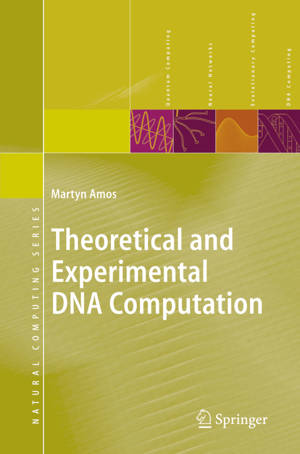
Je cadeautjes zeker op tijd in huis hebben voor de feestdagen? Kom langs in onze winkels en vind het perfecte geschenk!
- Afhalen na 1 uur in een winkel met voorraad
- Gratis thuislevering in België vanaf € 30
- Ruim aanbod met 7 miljoen producten
Je cadeautjes zeker op tijd in huis hebben voor de feestdagen? Kom langs in onze winkels en vind het perfecte geschenk!
- Afhalen na 1 uur in een winkel met voorraad
- Gratis thuislevering in België vanaf € 30
- Ruim aanbod met 7 miljoen producten
Zoeken
€ 139,95
+ 279 punten
Uitvoering
Omschrijving
DNA computation has emerged in the last ten years as an exciting new - search ?eld at the intersection (and, some would say, frontiers) of computer science, biology, engineering, andmathematics.AlthoughanticipatedbyFe- man as long ago as the 1950s [59], the notion of performing computations at a molecular level was only realized in 1994, with Adleman's seminal work [3] on computing with DNA. Since then the ?eld has blossomed rapidly, with signi?cant theoretical and experimental results being reported regularly. Several books [120, 39] have described various aspects of DNA compu- tion, but this is, to the author's best knowledge, the ?rst to bring together descriptions of both theoreticaland experimentalresults.The targetaudience is intentionally broad, including students as well as experienced researchers. We expect that users of the book will have some background in either c- puter science, mathematics, engineering, or the life sciences. The intention is that this book be used as a tutorial guide for newcomers to the ?eld as well as a reference text for people already working in this fascinating area. To this end, we include two self-contained tutorial chapters (1 and 2), which convey only those aspects of computer science and biology that are required to understand the subsequent material.
Specificaties
Betrokkenen
- Auteur(s):
- Uitgeverij:
Inhoud
- Aantal bladzijden:
- 173
- Taal:
- Engels
- Reeks:
Eigenschappen
- Productcode (EAN):
- 9783540657736
- Verschijningsdatum:
- 23/06/2005
- Uitvoering:
- Hardcover
- Formaat:
- Genaaid
- Afmetingen:
- 164 mm x 242 mm
- Gewicht:
- 403 g

Alleen bij Standaard Boekhandel
+ 279 punten op je klantenkaart van Standaard Boekhandel
Beoordelingen
We publiceren alleen reviews die voldoen aan de voorwaarden voor reviews. Bekijk onze voorwaarden voor reviews.









